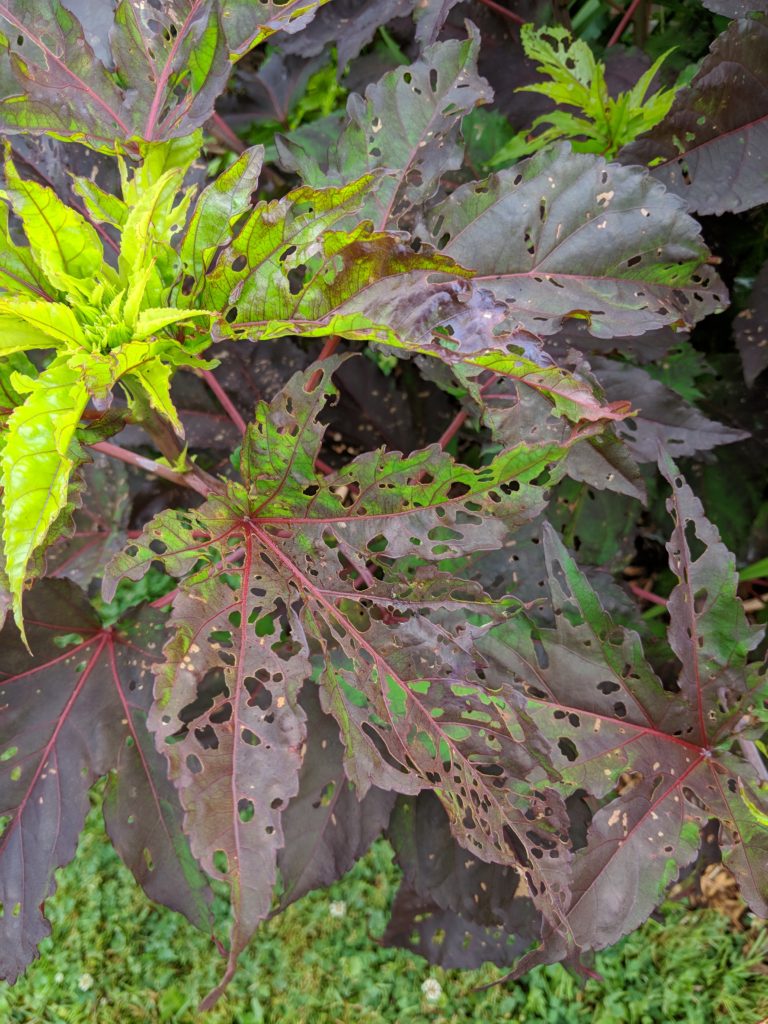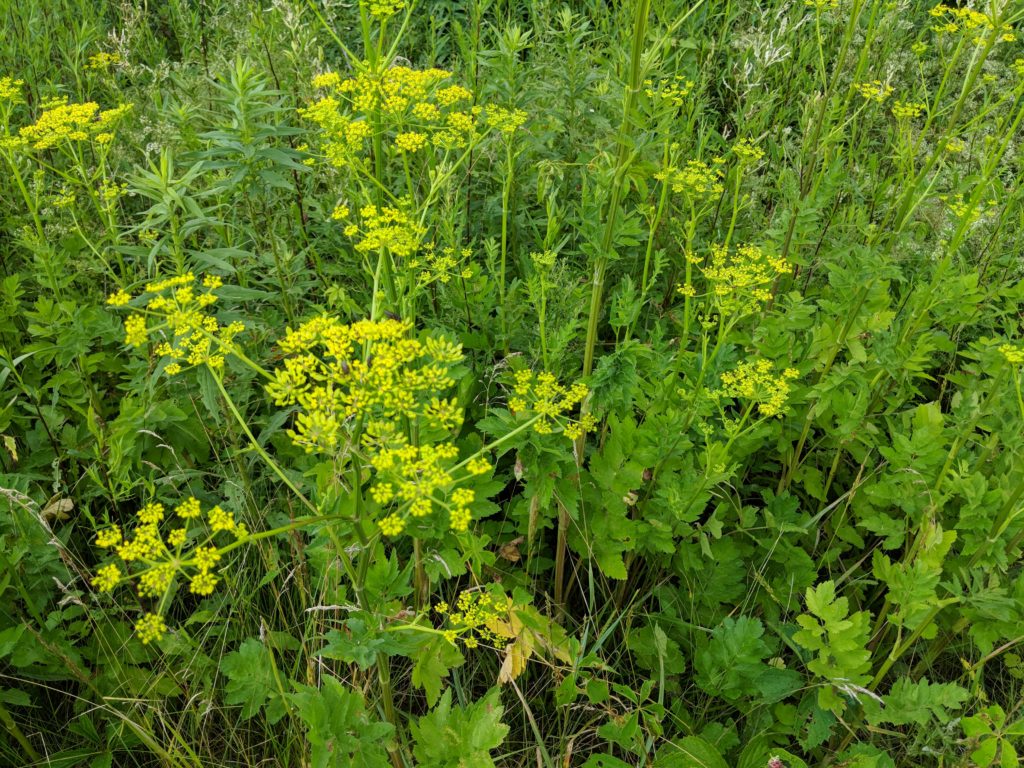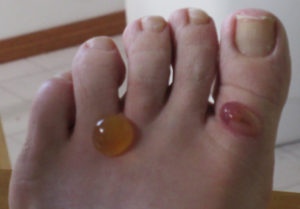The Village Gardener: The Good, the Bad and the Ugly
by Georgeanne Vyverberg –

It’s somewhere in the 90s with record high humidity and I have just returned from my second of three trips per day around my yard encouraging those beautiful but hated scarab beetles called Japanese Beetles to take a bath in my jar of soapy water. Some of my favorite plants have lacey leaves from their voracious feeding. So much work being destroyed by this creature is disturbing. In Japan they don’t have this problem with them as they also have natural predators. These pests were introduced to the United States by a shipment of Iris in soil from Japan. There were laws on the books even then stating no plant materiel could be allowed in with soil on them. Somebody was not doing their job.
There is some work being done to encourage predators here to help control them. By encouraging these beneficial insects of the fly and wasp family (Tiphia vernalis and Tiphia popilliavora) to our yards has been seen to be effective. How do we attract these insects to our yards? Well, basics like food, water and shelter can be offered by having early blooming plants since these predators are early arrivals and need to be encouraged to stay until other plants are flowering. Using any chemicals even organic ones can be deadly to them so care in their use is needed. A wide variety of plant and plant families in a garden are another important factor.
There has been some success using milky spore bacteria sprayed on lawns in the Fall when the eggs hatch into larvae and feed on the spores which are deadly to them. Mixed results with this method is that large areas need to be sprayed. If your neighbor doesn’t do it the likelihood of re-infestation is probable. There really seems to be no one answer, but I know that my thrice daily excursions around the yard are helping. I definitely see fewer on a daily basis. They seem to have a kind of daily routine themselves. The relative cool of the morning finds them nestled in the buds of flowers, especially roses and on the tops of plants sipping dew. By noonday heat they are often congregating on certain plants like my prized Hydrangea, flying about chasing and mating. They seem preoccupied and I usually can get quite a few then. My evening trek finds them hiding underneath leaves often in twos and threes and they seem lethargic but harder to find. Probably they are worn out by chasing and mating all afternoon.
Then there are the Beetle traps with an enticing fragrance to attract them to their death. But there is much controversy about these traps. Some say they just draw more beetles from further away and some never go in the traps. I have seen traps with hundreds of dead beetles though so they can’t be that useless. I guess I will simply keep using my soapy bath ritual. They will be gone soon..at least the beetle stage. It takes about 40 days from their emergence from the soil to completion of their life cycle or the beginning of the new one.

Photo Georgeanne Vyverberg
Recently, driving the Bristol Hills of the Central Finger Lakes region I couldn’t help but notice the thousands of Wild Parsnip plants growing along the roadsides. It’s a plant that I am very familiar with but even ten years ago I never saw it in such abundance. Somehow it is gaining quite a range and I wonder if its because of its toxic nature. It can cause a severe rash much like poison ivy. Perhaps like goldenrod plants and walnut trees they release toxin into the soil that inhibits the growth of some plants. Wild Parsnips belong to a group of plants known Botanically as the Umbelliferae or Apiacea, but most recognize them as the Parsley family. Many of the plants in this group are fragrant and useful for food or medicine, but some like Wild Parsnip and Giant Hogweed are toxic and even deadly like Water Hemlock. The problem also arises when there are several plants in this family that look so much alike that they could be mistaken for an edible plant. For example, Angelica and Water Hemlock look alike and grow in similar habitats. So, one needs to be careful and sure about identification before use. Also, the DEC wants to know the sites of any Giant Hogweed so it can be safely removed. According to a recent article in Scientific American Magazine it’s the sap which contain chemicals that bind with our own cell’s DNA and then activated by sunlight that cause the burns. So if one does encounter these plants and touches them it is recommended that washing with soapy water and keeping the area covered so that sunlight can’t activate the rash.

Photo Len Geller
Giant Hogweed is native to the Caucasus in Asia. It was collected and brought to the United States as an addition to gardens in 1917. I’ve said before how we gardeners want the next newest thing and sometimes it is our undoing. It’s interesting to note however that these same chemicals causing severe dermatitis can also be altered to aid in skin problems like psoriasis.
Enough said about the bad and ugly! Many plants in the Parsley family are revered for their use as food and food seasoning and in traditional medicine. Dill is one of my favorites to grow. It is a handsome plant in any garden and easily self-seeds and so you only need to plant it once. Its leaves are delicate and so is the flavor. I usually dry some but find its better to freeze the leaves and then cut them with a scissors when needed. That is if one has a spacious freezer. Many of the delicate herbs are more flavorful this way. Another favorite is Coriander and has been grown for over 3000 years and has been found in Egyptian tombs. It has also had the reputation as an aphrodisiac.
A list of the parsley family which has nearly 4000 species includes familiar plants like sweet cecily, parsnips, celery, fennel, lovage, sea holly, and chervil. Many have a long history of use and in addition they are attractive to butterflies, moths and bees. This alone makes them a beautiful and useful addition to any garden. It’s isn’t too late to plant many of these herbs and even things such as parsley and dill are quick growing and could be planted where earlier crops are finished. It’s good to succession plant many of these anyhow. Try planting some dill seed along with your next planting of beans. They compliment one another and you will have the main ingredients for dilly beans too.